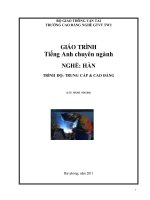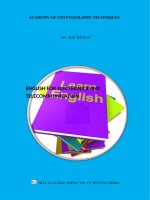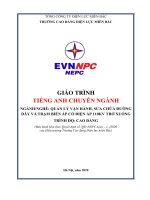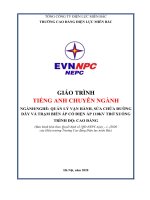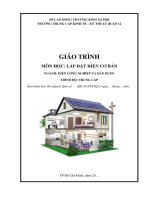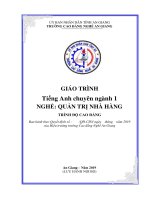giáo trình tiếng anh chuyên ngành điện nghề điện công nghiệp và dân dụng trung cấp
Bạn đang xem bản rút gọn của tài liệu. Xem và tải ngay bản đầy đủ của tài liệu tại đây (567.43 KB, 54 trang )
<span class="text_page_counter">Trang 1</span><div class="page_container" data-page="1">
Sæ LAO ĐàNG TH¯¡NG BINH VÀ Xà HàI ĐÀK LÀK
<b>TRƯỜNG TRUNG C¾P TRƯỜNG SƠN </b>
</div><span class="text_page_counter">Trang 2</span><div class="page_container" data-page="2"><b>TUYÊN BỐ BẢN QUYÀN </b>
Tài liáu này thc lo¿i sách giáo trình nên các nguồn thơng tin có thể đ°ÿc
khÁo.
Mãi māc đích khác mang tính lách l¿c hoặc sử dāng vãi māc đích kinh
</div><span class="text_page_counter">Trang 3</span><div class="page_container" data-page="3"><b>LỜI GIàI THIÞU </b>
Môn hãc <Ti¿ng anh chuyên ngành đián= là mát trong những môn hãc
do tr°ång Trung cÃp Tr°ång S¢n ban hành dành cho há trung cÃp ngành đián
Giáo trình đ°ÿc biên so¿n làm tài liáu hãc t¿p, ging dy nờn giỏo trỡnh ó c xõy dng ỗ mc ỏ Ân gin v dò hiu, trong mòi bi đÁu có các bài t¿p áp dāng để hãc sinh sinh viên thực hành, luyán t¿p kỹ năng nghÁ.
dung ch°¢ng trình đào t¿o, phù hÿp vãi māc tiêu đào t¿o và các nái dung thực hành đ°ÿc biên so¿n gÁn vãi yêu cầu thực t¿.
Unit 1: Electric tools
Unit 2: Measuring instruments
Unit 3: Electric materials: Conductors, insulators and semiconductors Unit 4: Circuit elements
Unit 5: The DC motor Unit 6: Transformers
Unit 7: Installation of lighting systems Unit 8: Electrical labor safety
Giáo trình cũng là tài liáu hãc t¿p, giÁng d¿y và tham khÁo tát cho các
có đÁ ra nái dung thực t¿p căa từng bài để ng°åi hãc căng cá và áp dāng ki¿n thức lý thy¿t đã hãc phù hÿp vãi kỹ năng.
ĐÁk LÁk, ngày 15 tháng 12 năm 2022 Tham gia biên so¿n
1. Chă biên
</div><span class="text_page_counter">Trang 4</span><div class="page_container" data-page="4"><b>MỵC LỵC </b>
<small>TUYấN B BN QUYN ... II LäI GIâI THIàU ... III MĀC LĀC ... IV </small>
<small>GIÁO TRÌNH MƠN HâC ... 1 </small>
<small>I. Và TRÍ, TÍNH CHÂT, Ý NGH)A VÀ VAI TRỊ CĂA MƠN HâC: ... 1 </small>
<small>II. MĀC TIÊU CĂA MÔN HâC: ... 1 </small>
<small>BÀI 1: ELECTRIC TOOLS ... 2 </small>
<small>UNIT 2: MEASURING INSTRUMENTS ... 5 </small>
<small>1. MĀC TIÊU CĂA BÀI: ... 5 </small>
<small>2. NàI DUNG BÀI: ... 6 </small>
<small>1. MĀC TIÊU CĂA BÀI: ... 11 </small>
<small>2. NàI DUNG BÀI: ... 11 </small>
<small>2.1. Vocabulary... 11 </small>
<small>2.2. Grammar ... 13 </small>
<small>2.3. Reading comprehension ... 14 </small>
<small>2.4. Exercises ... 14 </small>
<small>UNIT 4: CIRCUIT ELEMENTS ... 18 </small>
<small>1. MĀC TIÊU CĂA BÀI: ... 18 </small>
<small>2. NàI DUNG BÀI: ... 18 </small>
<small>2.1. Vocabulary... 18 </small>
<small>2.2. Grammar ... 19 </small>
</div><span class="text_page_counter">Trang 5</span><div class="page_container" data-page="5"><small>2.3. Reading comprehension ... 20 </small>
<small>2.4. Exercises ... 21 </small>
<small>UNIT 5: THE DC MOTOR ... 24 </small>
<small>1. MĀC TIÊU CĂA BÀI: ... 24 </small>
<small>2. NàI DUNG BÀI: ... 24 </small>
<small>2.1. Vocabulary... 24 </small>
<small>2.2. Grammar ... 25 </small>
<small>2.4. Exercises ... 27 </small>
<small>UNIT 6: TRANSFORMERS ... 31 </small>
<small>1. MĀC TIÊU CĂA BÀI: ... 31 </small>
<small>2.NàI DUNG BÀI: ... 31 </small>
<small>2.1. Vocabulary... 31 </small>
<small>2.2. Grammar ... 32 </small>
<small>2.3. Reading comprehension ... 33 </small>
<small>2.4. Exercises ... 33 </small>
<small>UNIT 7: INSTALLATION OF LIGHTING SYSTEMS ... 37 </small>
<small>1. MĀC TIÊU CĂA BÀI: ... 37 </small>
<small>2. NàI DUNG BÀI: ... 37 </small>
<small>2.1. Vocabulary... 37 </small>
<small>2.2. Grammar ... 37 </small>
<small>2.3. Reading comprehension ... 38 </small>
<small>2.4. Exercises ... 40 </small>
<small>UNIT 8: ELECTRICAL LABOR SAFETY ... 43 </small>
<small>1. MĀC TIÊU CĂA BÀI: ... 43 </small>
<small>2.NàI DUNG BÀI: ... 43 </small>
</div><span class="text_page_counter">Trang 6</span><div class="page_container" data-page="6"><b>GIÁO TRÌNH MƠN HàC Tên mơ đun: Ti¿ng anh chun ngành đißn </b>
<b>Mã mơ đun: MĐ22 </b>
<b>I. Vß trí, tính ch¿t, ý nghĩa và vai trị của mơn hác: </b>
- Vá trí:
các mơ đun, mô đun đào t¿o kỹ thu¿t lÁp đặt đián và điÁu khiển trong công nghiáp.
hay trong môi tr°ång doanh nghiáp.
<b>II. Mÿc tiêu của môn hác: </b>
+ Xác đánh đ°ÿc các dāng cā, trang thi¿t bá đián trong các bÁn vẽ, các
m¿ch, các bÁn vẽ đián bằng ti¿ng Anh
+ Rgn lun tính cऀn th¿n, tß mß, chính xác, t° duy khoa hãc, an toàn và ti¿t kiám.
</div><span class="text_page_counter">Trang 7</span><div class="page_container" data-page="7"><b>BÀI 1: ELECTRIC TOOLS Mã Bài: 01 </b>
<b>2. Nßi dung chính: 2.1. Vocabulary </b>
h¿t nhân
ho¿t, linh đáng
</div><span class="text_page_counter">Trang 9</span><div class="page_container" data-page="9">junction box: háp đầu mái
(-) This tool isn't called a screwdriver
These tools are not called conduit- blending pincers. (?) - Is this tool called a knife?
</div><span class="text_page_counter">Trang 10</span><div class="page_container" data-page="10">2.Pincers are three types: 150mm, 175mm and 200mm. -150mm: joint the small size
-175mm: for general electric work -200mm: for overhead wire work.
<b>2.Nippers </b>
1.As the wire jointed the terminal it is cutting wire core.
2. Cutting the flexible wire, fine soiled Hl.4, wire and shild wire, stripping the insulation cord wire and lead wire.
<b>3. Long nose pliers </b>
1. Holding the end of lead wire or stripping the insulation wire. 2. Making the terminal as joints the apparatus and blending the wire. 4. Wire strippers
1. It is automatic stripping the covered wire.
2. Confirm the size of wire core stripper find the same size groove with stripper.
<b>1. Mÿc tiêu của bài: </b>
- Bi¿t giao ti¿p trong môi tr°ång doanh nghiáp
</div><span class="text_page_counter">Trang 11</span><div class="page_container" data-page="11"><b>2. Nßi dung bài: 2.1. Vocabulary </b>
</div><span class="text_page_counter">Trang 12</span><div class="page_container" data-page="12">description : miêu tÁ
3. Do not solder transistors without a heat- shunt.
<b>Simple instruction use the infinitive </b>
Write the instructions to measure the total resistance of resistors in parallel, using the circuit in figure 1.
Connect up the apparatus as shown in figure 1.
<b>Describing an experiment </b>
Make a description of the first experiment by rewriting each instruction in the present passive.
Example:
1. Use a high - resistance voltmeter and a low - resistance ammeter.
►A HIGH - RESISTANCE VOLTMETER AND A LOW - RESISTANCE AMMETER IS USED
Make a report of the second experiment by rewriting each of your instruction in the past passive
2. Connect up the apparatus as shown in figure 1,
► THE APPARATUS WAS CONNECTED UP AS SHOWN IN FIGURE 1.
<b>2.3. Reading comprehension </b>
<b>MEASURE THE TOTAL RESISTANCE OF RESISTORS </b>
</div><span class="text_page_counter">Trang 13</span><div class="page_container" data-page="13">1. Use a high - resistance voltmeter and a low - resistance ammeter 2. Connect R1 across AB
3. Close the switch and adjust the rheostat until both meters show almost full scale deflection.
4. Take simultaneous readings of both voltage and current. 5. Calculate R1 by the formula R
6. Repeat this for R2
7. Connect R1 and R2 in series across AB .
8. Calculate the total resistance using the same formula as before. 9. Tabulate the results
<b>2.4. Exercises Exercise 1 </b>
- What is this object called in English? - It is called an ammeter
... ... ...
</div><span class="text_page_counter">Trang 16</span><div class="page_container" data-page="16"><b>UNIT 3: ELECTRIC MATERIALS : CONDUCTORS, INSULATORS ANH SEMICOUDUCTORS </b>
<b>1. Mÿc tiêu của bài: </b>
v¿t liáu đián : chÃt dẫn đián, chÃt cách đián và chÃt bán dẫn
c¢ bÁn trong ti¿ng Anh.
- Bi¿t giao ti¿p trong môi tr°ång doanh nghiáp
<b>2. Nßi dung bài: 2.1. Vocabulary </b>
</div><span class="text_page_counter">Trang 18</span><div class="page_container" data-page="18">Quote : låi trích dẫn
Study these sentences :
1. Starter motor brushes are made of carbon 2. The carbon contains copper.
Both these sentences refer to carbon. We can link them by making sentence 2 a relative clause.
Example'.
► Starter motor brushed are made of carbon WHICH CONTAINS COPPER.
</div><span class="text_page_counter">Trang 19</span><div class="page_container" data-page="19">The relative clause is in capitals. Note that the carbon in sentence 2 becomes WHICH.
Study these other pairs of sentences and note how they are linked: 3. Consumers are supplied at higher voltages than domestic consumers. 4. These consumers use large quantities of energy.
► Consumers WHO USE LARGE QUANTITIES OF ENERGY are supplied at higher voltages than domestic consumers.
5, 33 kV lines are fed to intermediate substations.
6. In the intermediate substations the voltage is stepped down to 11 kV.
► 33 kV lines fed to intermediate substations WHERE THE VOLTAGE IS STEPPED DOWN TO 11 kV.
<b>2.3. Reading comprehension </b>
<b>CONDUCTORS, INSULATORS AND SEMICONDUCTORS </b>
If we connect a battery across a body, there is a movement of free electrons towards the positive end. This movement of electrons is an electric current. All materials can be classified into three groups according to how readily they permit an electric current to flow. These are : conductors , insulators and semiconductors.
In the first category are substances which provide an easy path for an electric current. All metals are conductors, however some metals do not conduct well. Mangarin, for example, is a poor conductor. Copper is a good conductor, therefore it is widely used for cables. A non- metal which conducts Well is carbon. Salt water is an example of a liquid conductor.
A material which does not easily release electron is called an insulator. Rubber, nylon, porcelain and air are all insulators. There are no perfect insulators. All insulators will allow some flow of electrons, however this can usually be ignored because the flow they permit so small.
Semiconductors are midway between conductors and insulators. Under certain conditions they allow a current to flow easily but under others they behave as insulators. Germanium and silicon are semiconductors. Mixtures of certain metallic oxides also act as semiconductors. These are known as thermistors. The resistance of thermistors falls rapidly as they temperature rises. They are therefore used in temperature - sensing devices.
<b>2.4. Exercises </b>
</div><span class="text_page_counter">Trang 20</span><div class="page_container" data-page="20">1. The flow of free electrons is an electric current. 2. Materials in the first group are called conductors.
3. Materials which provide a path for an electric current are conductors. 4. All insulators permit some flow of electrons.
5. Germanium sometimes acts as an insulator and sometimes as a conductor. Exercise 2
Contextual reference
What do the pronouns in italics in these sentences refer to?
1. All materials can be classified into three groups according to how readily they permit an electric cunent to flow.
a. three groups b. all materials c. free electrons
2. Under certain conditions they allow a cunent to flow easily but under others they behave as insulators.
a. conductors b. semiconductors c. insulators
3. These are known as thermistors. a. metallic oxides
b. semiconductors
c. mixtures of certain metallic oxides
4. They are therefore used in temperature- sensing devices a. thermistors
b. semiconductors c. metallic oxides Exercise 3
Checking facts and ideas
Decide if these statements are true or false. Quote from the passage to support your decisions. Correct the false statements
1. Electrons flow from positive to negative.
2. Copper provides an easy path for an electric current. 3. All metals are good conductors.
</div><span class="text_page_counter">Trang 21</span><div class="page_container" data-page="21">4. All good conductors are metals. 5. Air is not a perfect insulator. 6. Rubber readily releases electrons.
7. The resistance of a thermistor is higher at low temperatures than at high temperatures.
Exercise 4
Relative clause 1. Study these sentences :
1. Starter motor brushes are made of carbon 2. The carbon contains copper.
Both these sentences refer to carbon. We can link them by making sentence 2 a relative clause.
Example'.
► Starter motor brushed are made of carbon WHICH CONTAINS COPPER.. The relative clause is in capitals. Note that the carbon in sentence 2 becomes WHICH.
Study these other pairs of sentences and note how they are linked: 3. Consumers are supplied at higher voltages than domestic consumers. 4. These consumers use large quantities of energy.
Example9.
► Consumers WHO USE LARGE QUANTITIES OF ENERGY are supplied at higher voltages than domestic consumers.
5. 33 kV lines are fed tã intermediate substations.
6. In the intermediate substations the voltage is stepped down to 11 kV. Example:
44► 33 kv lines fed to intermediate substations WHERE THE VOLTAGE IS STEPPED DOWN TO 11 kV.
Now link these sentences. Make the second sentence in each pair a relative clause:
1. The coil is connected in series with a resistor. The resistor has a value of 240 ohms.
</div><span class="text_page_counter">Trang 22</span><div class="page_container" data-page="22">The workers assemble very small precision instruments. 4. Manganin is a metal.
This metal has a comparatively high resistance 5. The signal passes to the detector.
The signal is rectified by the detector 6. A milliameter is an instrument.
The instrument is used for measuring small current
7. Workers require illumination of 300 lux. The workers assemble heavy machinery.
8. Armoured cables are used in places.
There is a risk of mechanical damage in these places.
</div><span class="text_page_counter">Trang 23</span><div class="page_container" data-page="23"><b>UNIT 4: CIRCUIT ELEMENTS 1. Mÿc tiêu của bài: </b>
tử m¿ch.
- Bi¿t giao ti¿p trong môi tr°ång doanh nghiáp
<b>2. Nßi dung bài: 2.1. Vocabulary </b>
</div><span class="text_page_counter">Trang 24</span><div class="page_container" data-page="24">conduct regulate : đổi, bi¿n đổi
<b>2.2. Grammar </b>
Current moves from a point of high potential energy to one of low potential. This path is called an electric circuit.
The source can be any device which supplies electrical energy.
It may control the current by limiting it, as does a rheostat, or by interrupting it, as does a switch.
When we answer the question What is X for?, we describe the purpose of X . Example
- What is an ammeter for ? - It is for measuring current.
Other ways we can describe the purposes of an ammeter are 1. It is used for measuring current
2. It is used to measure current
3. We measure current with an ammeter 4. We measure current using an ammeter
</div><span class="text_page_counter">Trang 25</span><div class="page_container" data-page="25"><b>2.3. Reading comprehension </b>
<b>CIRCUIT ELEMENTS </b>
Current moves from a point of high potential energy to one of low potential. It can only do so if there is a path for it to follow. This path is called an electric circuit. All circuits contain four elements: a source, a load, a
transmission system and a control.
The source provides the electromotive force. This establishes the difference in potential which makes current flow possible. The source can be any device which supplies electrical energy. For example, it may be a generator or a battery.
The load converts the electrical energy from the source into some other form of energy. For instance, a lamp changes electrical energy into light and heat. The load can be any electrical device.
The °ansmission system conducts the current round the circuit. Any conductor can be a part of a transmission system. Most systems consist of wires. It is often possible, however, for the metal frame of a unit to be one section of its transmission system. For example, the metal chassis of many electrical devices are used to conduct current. Similarly the body of a car is part of its electrical transmission system.
The control regulates the current flow in the circuit. It may control the current by limiting it, as does a rheostat, or by interrupting it, as does a switch.
Study Figure 1. In this simple flashlight circuit, the source comprises three 1.5 V cell in series. The load is a 0.3 w bulb. Part of the transmission system is the metal body of the flashlight, and the control is a sliding switch.
</div><span class="text_page_counter">Trang 26</span><div class="page_container" data-page="26"><b>FIGURE 2 </b>
Compare figure 2. The function of this circuit is to operate a television camera aboard a space satellite. Here the source is a battery of solar cells. A solar cell is an electric cell which converts sunlight into electrical energy. The load is the television camera. The transmission system is the connecting wires. The control is a relay actuated by transmissions from ground control. Although the function of this circuit is much more complex than that of the flashlight, it too consists of the four basic elements.
<b>2.4. Exercises </b>
Exercise 1 Rephrasing
Rewrite the following sentences, replacing the words in italics with expressions from the passage which have a similar meaning.
1. A lamp converts electrical energy into light.
2. The generator provides the circuit with electromotive force.
3. The metal frame of the oscilloscope is part of its transmission system. 4. The rheostat controls the current flow in the circuit.
5. A battery of solar cells supplies power to the circuit. Exercise 2
Contextual reference
What do the pronouns in italics refer to?
1. Current moves from a point of high potential energy to one of low potential. a. current
</div><span class="text_page_counter">Trang 27</span><div class="page_container" data-page="27">b. energy c. a point
2. For example, it may be a generator or a battery. a. the source
Checking facts and ideas
Decide if these statements are true or false. Quote from ■ the passage to support your decisions. Correct the false sentences.
1. A difference in potentials required before current can flow in a circuit. 2. A generator is a source of electromotive force.
3. Loads convert electric energy into light and heat. 4. Transmission systems must consist of wires. 5. A rheostat may be used as a control.
6. The load in the flashlight circuit is a bulb. 7. The source in the satellite circuit is a solar cell.
8. The current flow in the satellite circuit is generates by a relay. 9. The flashlight circuit differs basically from the satellite circuit. Exercise 4
</div>

